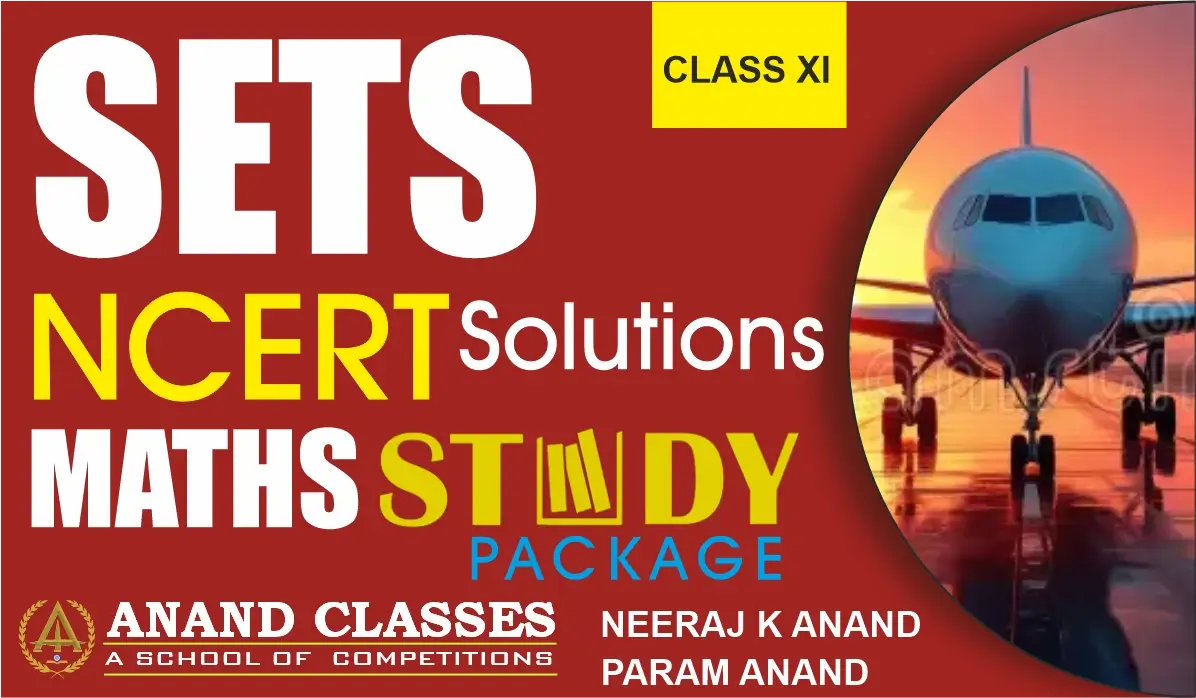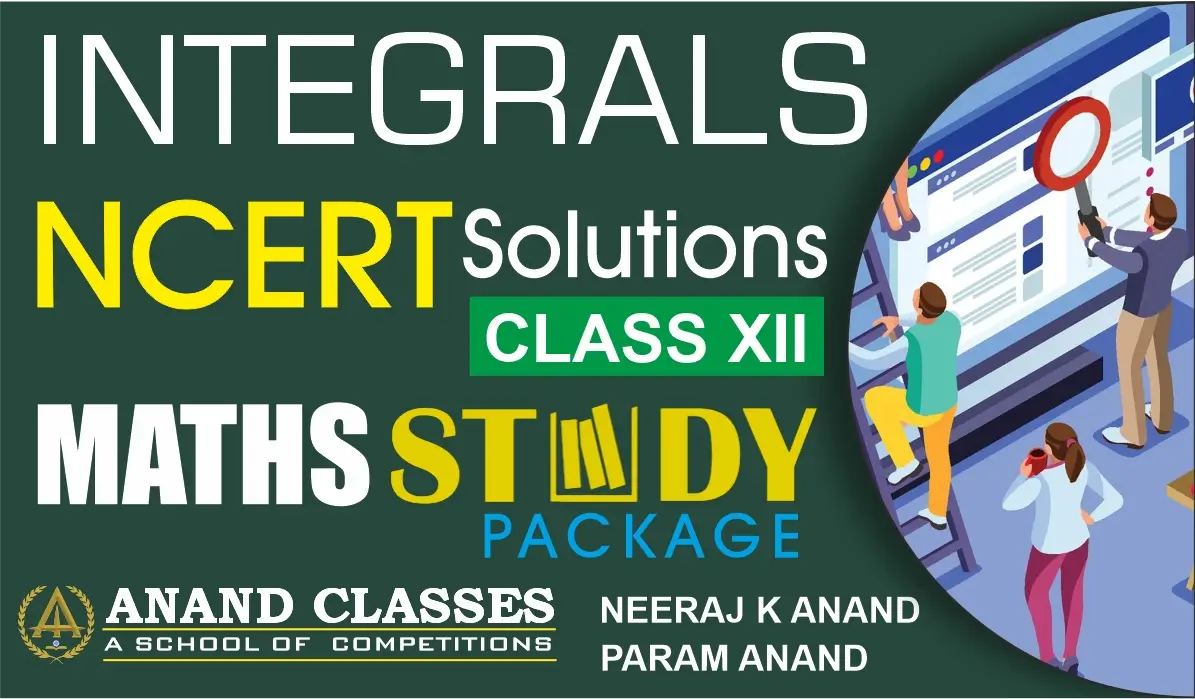Anand Classes provides comprehensive and well-explained Sets NCERT Solutions Miscellaneous Exercise Class 11 Maths Chapter 1 to help students achieve a strong grasp of set theory concepts. These solutions strictly follow the latest NCERT and CBSE syllabus, offering clear, step-by-step explanations for each problem. Ideal for Class 11 students preparing for exams, these Miscellaneous Exercise solutions make complex problems easy to understand and boost confidence in tackling higher-level questions. Click the print button to download study material and notes.
NCERT NCERT Question 1 : Decide, among the following sets, which sets are subsets of one another:
$A = \{x : x \in \mathbb{R} \text{ and } x \text{ satisfy } x^2 – 8x + 12 = 0\}$
$B = \{2, 4, 6\}$
$C = \{2, 4, 6, 8, \dots\}$
$D = \{6\}$
Solution :
First simplify set $A$:
Solve the equation
$$x^2 – 8x + 12 = 0$$
Factorizing,
$$(x – 6)(x – 2) = 0$$
So,
$$x = 6 \quad \text{or} \quad x = 2$$
Thus,
$$A = \{2, 6\}$$
A set $X$ is a subset of a set $Y$ if every element of $X$ is also an element of $Y$.
Therefore:
- $\{2,6\} \subset \{2,4,6\}$ ⇒ $A \subset B$
- $\{2,6\} \subset \{2,4,6,8,\dots\}$ ⇒ $A \subset C$
- $\{2,4,6\} \subset \{2,4,6,8,\dots\}$ ⇒ $B \subset C$
- $\{6\} \subset \{2,6\}$ ⇒ $D \subset A$
- $\{6\} \subset \{2,4,6\}$ ⇒ $D \subset B$
- $\{6\} \subset \{2,4,6,8,\dots\}$ ⇒ $D \subset C$
Final Answer
$$A \subset B,\quad A \subset C,\quad B \subset C,\quad D \subset A,\quad D \subset B,\quad D \subset C$$
High-quality math notes and resources available from Anand Classes for excellent exam preparation.
NCERT Question 2: In each of the following, determine whether the statement is true or false. If it is true, prove it. If it is false, give an example.
(i) If $x \in A$ and $A \in B$, then $x \in B$.
(ii) If $A \subset B$ and $B \in C$, then $A \in C$.
(iii) If $A \subset B$ and $B \subset C$, then $A \subset C$.
(iv) If $A \not\subset B$ and $B \not\subset C$, then $A \not\subset C$.
(v) If $x \in A$ and $A \not\subset B$, then $x \in B$.
(vi) If $A \subset B$ and $x \notin B$, then $x \notin A$.
Solution :
(i) If $x \in A$ and $A \in B$, then $x \in B$.
Answer: False.
Counterexample: Let $x=1$, $A=\{1,2,3\}$ and $B=\{\{1,2,3\},\{4,5,6\}\}$. Then $x\in A$ and $A\in B$, but $x\notin B$ because elements of $B$ are sets, not the number $1$; specifically $1\notin B$.
(ii) If $A \subset B$ and $B \in C$, then $A \in C$.
Answer: False.
Counterexample: Let $A=\{1\}$, $B=\{1,3\}$ and $C=\{\{1,3\},\{5,7\}\}$. Then $A\subset B$ and $B\in C$, but $A\notin C$ since $C$ contains $\{1,3\}$ and $\{5,7\}$, not $\{1\}$.
(iii) If $A \subset B$ and $B \subset C$, then $A \subset C$.
Answer: True.
Proof: $A\subset B$ means every element of $A$ is in $B$. $B\subset C$ means every element of $B$ is in $C$. Therefore every element of $A$ (being in $B$) is also in $C$. Hence $A\subset C$.
(iv) If $A \not\subset B$ and $B \not\subset C$, then $A \not\subset C$.
Answer: False.
Counterexample: Let $A=\{1,2\}$, $B=\{3,4,5\}$ and $C=\{1,2,6,7\}$. Here $A\not\subset B$ (because $1\notin B$) and $B\not\subset C$ (because $3\notin C$), yet $A\subset C$ (every element $1,2$ of $A$ is in $C$). Thus the given implication is false.
(v) If $x \in A$ and $A \not\subset B$, then $x \in B$.
Answer: False.
Counterexample: Let $x=1$, $A=\{1,2\}$ and $B=\{3,4,5\}$. Then $x\in A$ and $A\not\subset B$ (since $1\notin B$), but $x\notin B$. So the statement is false.
(vi) If $A \subset B$ and $x \notin B$, then $x \notin A$.
Answer: True.
Proof: $A\subset B$ means every element of $A$ is also an element of $B$. If $x\notin B$, then $x$ cannot be an element of any subset $A$ of $B$. Hence $x\notin A$.
Download practice material from Anand Classes — perfect for CBSE and JEE preparation.
NCERT Question 3 : Let $A, B,$ and $C$ be the sets such that
$$A \cup B = A \cup C \quad \text{and} \quad A \cap B = A \cap C.$$
Show that $B = C$.
Solution :
Given:
$$A \cup B = A \cup C \quad …(1)$$
$$A \cap B = A \cap C \quad …(2)$$
We must show:
$$B = C$$
Proof
Let $x \in B$.
We consider two cases:
Case 1: $x \in A$
Since $x \in B$ and $x \in A$, then
$$x \in A \cap B$$
Using (2):
$$A \cap B = A \cap C \Rightarrow x \in A \cap C$$
Thus,
$$x \in C$$
Case 2: $x \notin A$
Since $x \in B$, then
$$x \in A \cup B$$
Using (1):
$$A \cup B = A \cup C \Rightarrow x \in A \cup C$$
As $x \notin A$, it must be that:
$$x \in C$$
From both cases, we have
$$x \in B \Rightarrow x \in C \quad \Rightarrow \quad B \subset C$$
Similarly, reversing the role of $B$ and $C$, we get:
$$C \subset B$$
Thus,
$$B \subset C \quad \text{and} \quad C \subset B$$
Therefore,
$$\boxed{B = C}$$
Top-quality set theory solutions and study notes available from Anand Classes for CBSE and JEE preparation.
NCERT Question 4 : Show that the following four conditions are equivalent :
(i) $A \subset B$
(ii) $A – B = \varnothing$
(iii) $A \cup B = B$
(iv) $A \cap B = A$
Solution :
We will show each condition implies the other.
(i) ⇒ (ii)
If $A \subset B$, then every element of $A$ is also in $B$.
So, $A$ has no element outside $B$.
Therefore,
$$A – B = \varnothing$$
(i) ⇒ (iii)
Since all elements of $A$ are in $B$:
$$A \cup B = B$$
(i) ⇒ (iv)
Since $A \subset B$, every element of $A$ lies in $B$, so:
$$A \cap B = A$$
Now, reverse implications:
(ii) ⇒ (i)
Given $A – B = \varnothing$, there is no element of $A$ outside $B$.
Hence,
$$A \subset B$$
(iii) ⇒ (i)
From $A \cup B = B$, every element of $A$ is already in $B$.
Thus,
$$A \subset B$$
(iv) ⇒ (i)
From $A \cap B = A$, every element of $A$ also belongs to $B$.
Thus,
$$A \subset B$$
Final Conclusion
All four statements are logically equivalent:
$$A \subset B \iff A – B = \varnothing \iff A \cup B = B \iff A \cap B = A$$
Access high-quality exam-focused notes from Anand Classes for smart study and better results.
NCERT Question 5 : Show that if $A \subset B$, then $C – B \subset C – A$
Solution :
Let
$$A = \{1,2\}, \quad B = \{1,2,3,4,5\} \quad \text{and} \quad C = \{2,5,6,7,8\}$$
Since every element of $A$ is in $B$:
$$A \subset B$$
Now find the difference sets:
Elements in $C$ but not in $B$:
$$C – B = \{6,7,8\}$$
Elements in $C$ but not in $A$:
$$C – A = \{5,6,7,8\}$$
Checking subset relation
$\{6,7,8\}$ — these elements all appear in $\{5,6,7,8\}$
So we can clearly see:
$$C – B \subset C – A$$
Final Answer
$$\boxed{C – B \subset C – A}$$
For more easy and exam-focused math notes, explore Anand Classes resources for CBSE & JEE success!
NCERT Question 6 : Assume that $P(A) = P(B)$. Show that $A = B$
Solution :
$P(X)$ represents the power set of a set $X$.
Power set means the set of all subsets of a given set.
Example:
If $A = \{1,2\}$, then
$$P(A) = \{\varnothing, \{1\}, \{2\}, \{1,2\}\}$$
To prove $A = B$, we must prove:
- $A \subset B$
- $B \subset A$
Since $A$ is a set,
$$A \in P(A)$$
Given:
$$P(A) = P(B)$$
So:
$$A \in P(B)$$
That means $A$ is a subset of $B$:
$$A \subset B \quad …(1)$$
Similarly,
$$B \in P(B)$$
Since $P(A) = P(B)$,
$$B \in P(A)$$
So $B$ is a subset of $A$:
$$B \subset A \quad …(2)$$
From (1) and (2):
$$A \subset B \quad \text{and} \quad B \subset A \Rightarrow A = B$$
Final Answer
$$\boxed{A = B}$$
Enhance your understanding of set theory with expert notes from Anand Classes, ideal for CBSE and JEE preparation.
Question 7: Is it true that for any sets $A$ and $B$, $P(A) \cup P(B) = P(A \cup B)$? Justify your answer
Solution:
It is False.
Let:
$$A = \{1, 2\}$$
$$B = \{2, 3\}$$
Then:
$$A \cup B = \{1, 2, 3\}$$
Power sets:
$$P(A) = \{\varnothing, \{1\}, \{2\},\{1, 2\}\}$$
$$P(B) = \{\varnothing, \{2\}, \{3\}, \{2, 3\}\}$$
Their union:
$$P(A) \cup P(B) = \{\varnothing, \{1\}, \{2\}, \{3\}, \{1, 2\}, \{2, 3\}\} \quad \text{…(1)}$$
Now:
$$P(A \cup B) = \{\varnothing, \{1\}, \{2\}, \{3\},\{1, 2\}, \{2, 3\}, \{1, 3\}, \{1, 2, 3\}\} \quad \text{…(2)}$$
From (1) and (2):
$$P(A) \cup P(B) \ne P(A \cup B)$$
Hence, the statement is False.
NCERT Question 8: Show that for any sets $A$ and $B$,
$A = (A \cap B) \cup (A – B)$ and $A \cup (B – A) = (A \cup B)$
Solution:
Proof 1:
$$A = (A \cap B) \cup (A – B)$$
$$A =(A \cap B) \cup (A – B)$$
$$A =(A \cap B) \cup (A \cap B’) $$
since $(A – B) = (A \cap B’)$
$$A = A \cap (B \cup B’)$$
$$A = A \cap (U) = A $$
Since, $ B \cup B’ = U \text{ (Universal set)}$
Hence, it is proved that:
$$A = (A \cap B) \cup (A – B)$$
Proof 2:
$$ A \cup (B – A) = (A \cup B) $$
$$A \cup (B – A) = A \cup (B \cap A’) $$
since $(B – A) = (B \cap A’)$
$$(A \cup B) \cap (A \cup A’) \quad \text{// distributive law}$$
$$(A \cup B) \cap U \quad \text{// } A \cup A’ = U \text{ (Universal set)}$$
$$(A \cup B)$$
Hence, it is proved that:
$$A \cup (B – A) = (A \cup B)$$
NCERT Question 9: Using properties of sets, show that
(i) $A \cup (A \cap B) = A$
(ii) $A \cap (A \cup B) = A$
Solution:
(i) $A \cup (A \cap B)$
$$A \cup (A \cap B)$$
$$(A \cup A) \cap (A \cup B) \quad \text{// distributive law}$$
$$A \cap (A \cup B) \quad \text{// } A \cup A = A$$
$$A \quad \text{// absorption law}$$
Hence,
$$A \cup (A \cap B) = A$$
(ii) $A \cap (A \cup B)$
$$A \cap (A \cup B)$$
$$(A \cap A) \cup (A \cap B) \quad \text{// distributive law}$$
$$A \cup (A \cap B) \quad \text{// } A \cap A = A$$
$$A \quad \text{// absorption law}$$
Hence,
$$A \cap (A \cup B) = A$$
NCERT Question 10: Show that $A \cap B = A \cap C$
need not imply $B = C$
Solution:
Let us take a counterexample.
Let
$$A = \{1,2\}, \quad B = \{2,3\}, \quad C = \{2,4\}$$
Here, clearly $B \ne C$.
Now,
$$A \cap B = \{2\}$$
$$A \cap C = \{2\}$$
So,
$$A \cap B = A \cap C \quad \text{but} \quad B \ne C$$
Therefore, it is not necessary that $B = C$ whenever $A \cap B = A \cap C$.


